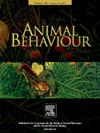Partial honesty in a hummingbird polymorphism provides evidence for a hybrid equilibrium
IF 2.3
2区 生物学
Q2 BEHAVIORAL SCIENCES
引用次数: 0
Abstract
Animal signals, while informative, are unlikely to be entirely reliable. Models of such partially honest communication have traditionally taken the form of ‘honest-enough’ signalling, in which a subset of signallers can signal at lower cost and therefore exaggerate their perceived ability or condition. Although support for these models has been demonstrated, alternatives are rarely tested in nature. Recent theory has highlighted an alternative model that also results in partial reliability, yet functions through a different mechanism. In so-called hybrid equilibria, all signallers pay the same costs given their condition, yet low-quality signallers sometimes spoof the high-quality signal, which receivers sometimes heed and sometimes ignore. Although theoretically well established, documentation of hybrid equilibria in nature is rare. Here, using previously collected behavioural data from the field and literature, we detail a game-theoretic model based on the natural history of hummingbirds. We demonstrate that an unusual female plumage polymorphism found in these birds is best explained as a hybrid equilibrium. In addition to explaining the persistence of polymorphism, the model also offers testable parameters that may predict the wide range of sex variation in plumage found across hummingbirds and other taxa, including bright and dull monomorphism and sexual dimorphism. Ultimately, our findings show that intersexual mimicry can be modelled as a hybrid equilibrium, that hybrid signals likely exist in nature, and that there is the need for a greater diversity of models to explain stable communication.
蜂鸟多态性的部分诚实性为杂交平衡提供了证据
动物的信号虽然能提供信息,但不太可能完全可靠。这种部分诚实的交流模式传统上采取了“足够诚实”的信号形式,其中一部分信号者可以以较低的成本发出信号,因此夸大了他们的感知能力或条件。尽管对这些模型的支持已经得到了证明,但在自然界中很少对替代模型进行测试。最近的理论强调了另一种模型,它也导致部分可靠性,但通过不同的机制起作用。在所谓的混合均衡中,所有的信号发送者在给定条件下付出相同的代价,然而低质量的信号发送者有时会欺骗高质量的信号,接收器有时会注意到,有时会忽略。虽然在理论上已经很好地建立了,但自然界中关于杂交平衡的文献很少。在这里,利用先前从野外收集的行为数据和文献,我们详细介绍了一个基于蜂鸟自然历史的博弈论模型。我们证明,在这些鸟类中发现的不寻常的雌性羽毛多态性最好解释为杂交平衡。除了解释多态性的持久性之外,该模型还提供了可测试的参数,可以预测在蜂鸟和其他分类群中发现的羽毛性别差异的广泛范围,包括明亮和暗淡的单态和两性二态。最终,我们的研究结果表明,两性间的模仿可以被建模为一种混合平衡,混合信号可能存在于自然界中,并且需要更多样化的模型来解释稳定的交流。
本文章由计算机程序翻译,如有差异,请以英文原文为准。
求助全文
约1分钟内获得全文
求助全文
来源期刊

Animal Behaviour
生物-动物学
CiteScore
4.60
自引率
8.00%
发文量
236
审稿时长
10.2 weeks
期刊介绍:
Growing interest in behavioural biology and the international reputation of Animal Behaviour prompted an expansion to monthly publication in 1989. Animal Behaviour continues to be the journal of choice for biologists, ethologists, psychologists, physiologists, and veterinarians with an interest in the subject.
 求助内容:
求助内容: 应助结果提醒方式:
应助结果提醒方式:


